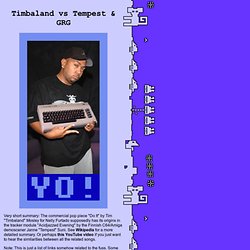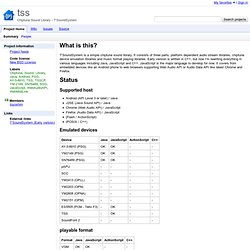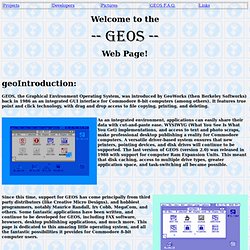

Matthew DiVito // MOTION // GRAPHIC // DESIGN. Dreamcast Programming. Timbaland vs Tempest & GRG. Very short summary: The commercial pop piece "Do It" by Tim "Timbaland" Mosley for Nelly Furtado supposedly has its origins in the tracker module "Acidjazzed Evening" by the Finnish C64/Amiga demoscener Janne "Tempest" Suni.

See Wikipedia for a more detailed summary. Or perhaps this YouTube video if you just want to hear the similarities between all the related songs. Note: This is just a list of links somehow related to the fuss. Some information presented as factual may actually be speculation or just plain wrong (even if repeated in multiple sources). The news about the new "Beaterator feat. God Bless This Grand Republic! Stone Oakvalley's Authentic SID Collection - www.6581-8580.com - Download MP3 files of SID recordings.
Tss - Chiptune Sound Library - T'SoundSystem. T'SoundSystem is a simple chiptune sound library.

It consists of three parts, platform dependent audio stream libraries, chiptune device emulation libraries and music format playing libraries. Early version is written in C++, but now I'm rewriting everything in various languages including Java, JavaScript and C++. JavaScript is the major language to develop for now. It covers from embedded devices like an Android phone to web browsers supporting Web Audio API or Audio Data API like latest Chrome and Firefox.
Supported host Android (API Level 3 or later) / Java J2SE (Java Sound API) / Java Chrome (Web Audio API) / JavaScript Firefox (Audio Data API) / JavaScript (Flash / ActionScript) (POSIX / C++) Emulated devices playable format misc features. RETRO Innovations - Classic Systems, Contemporary Gear. Just a little point and click. GEOS, the Graphical Environment Operating System, was introduced by GeoWorks (then Berkeley Softworks) back in 1986 as an integrated GUI interface for Commodore 8-bit computers (among others).

It features true point and click technology, with drag and drop access to file copying, printing, and deleting. As an integrated environment, applications can easily share their data with cut-and-paste ease. WYSIWYG (What You See Is What You Get) implementations, and access to text and photo scraps, make professional desktop publishing a reality for Commodore computers. A versatile driver-based system ensures that new printers, pointing devices, and disk drives will continue to be supported. The last version of GEOS (version 2.0) was released in 1988 with support for computer Ram Expansion Units.
Since this time, support for GEOS has come principally from third party distributors (like Creative Micro Designs), and hobbiest programmers, notably Maurice Randall, Irv Cobb, MegaCom, and others. The Erwin Tomash Library. The Erwin Tomash Library This catalog documents the collection (perhaps the best ever assembled) of books and manuscripts related to the history of computing.

It was put together, over many years, by Erwin Tomash - himself a pioneer in the development of computers. The collection consists of well over five thousand items from twelfth century manuscripts to modern publications. This catalog documents the rarest items (about 3,000, usually pre-1955) together with a series of essays that explain the uses of little known instruments and techniques that are discussed in the entries. Each entry consists of the usual bibliographic details, some biographical information on the author, a description of the contents, and illustrations of interesting pages and diagrams. How to use this catalog This catalog is almost 1600 pages long, consequently it can be difficult to navigate.
On the left hand side of the Adobe reader, you will see some tabs (on older readers) or icons (on newer versions).
Wolfenstein. TraxWeekly archive at OpenMPT.org. Welcome to the TraxWeekly archive!

Here, you can find all editions of the TraxWeekly newsletter. TraxWeekly was a text-only magazine for the tracker scene, modelled after the example of Hornet's "Demonews" publication. It was published semi-weekly between 1995 and 1998, eventually running for 119 issues. It contained relevant news, tracking tips, interviews, reviews, and unrelated fun stuff. Despite its age and varying quality, it is a must-read for those who wish to gain an insight in the early PC tracker scene. TRAXWEEK.117 (49.6 kB) 1 January 1998 TRAXWEEK.118 (51.1 kB) 27 January 1998 TRAXWEEK.119 (39.1 kB) 16 February 1998 Bonus Material Here is some artwork from the TraxWeekly newsletter, plus TraxWeekly issue #25 by Popcorn.